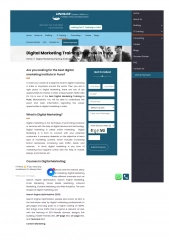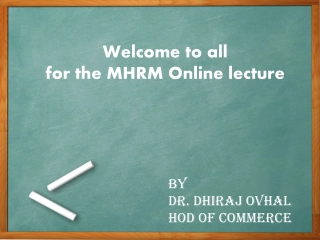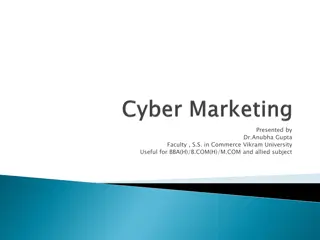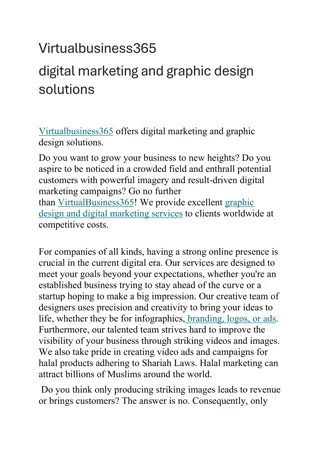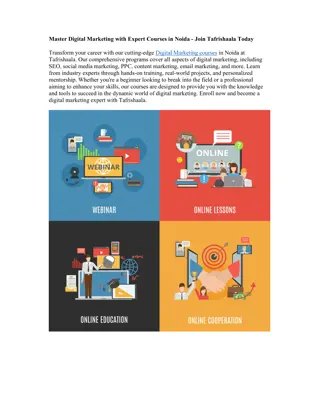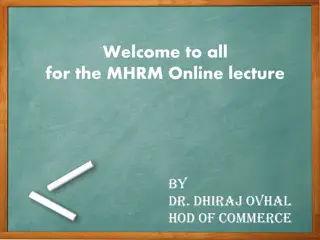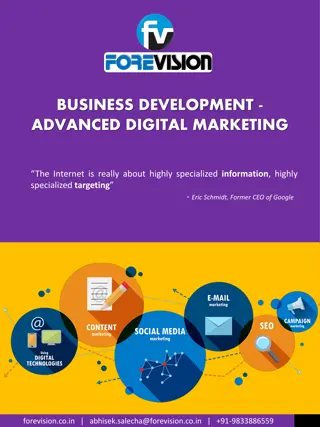
Marketing Environment and Importance for Success
Explore the significance of the marketing environment in shaping business success, illustrated with real-world examples like Nokia's decline due to overlooking environmental changes. Understand the constituents of the internal and external environment, including the micro and macro components.
Download Presentation

Please find below an Image/Link to download the presentation.
The content on the website is provided AS IS for your information and personal use only. It may not be sold, licensed, or shared on other websites without obtaining consent from the author. If you encounter any issues during the download, it is possible that the publisher has removed the file from their server.
You are allowed to download the files provided on this website for personal or commercial use, subject to the condition that they are used lawfully. All files are the property of their respective owners.
The content on the website is provided AS IS for your information and personal use only. It may not be sold, licensed, or shared on other websites without obtaining consent from the author.
E N D
Presentation Transcript
Unit-1 The Marketing Environment and Environment Scanning By Mrs Sarika Singh Faculty of Management Studies MLSU Udaipur
Marketing Environment Marketing Environment A company s marketing environment consists of the actors and forces outside of marketing that affect marketing management ability to build and maintain successful relationships with target customers . Philip Kotler . From the above definition we can extract that marketing environment consists of factors that are internal and external which may pose threats to a firm or provide opportunities for exploitation.
Importance of Marketing Environment 1) Essential for planning 2) Understanding Customers 3) Tap new trends 4) Keep a check on threats 5) Harp on the opportunities 6) Understand the competition 7) Helps building strategy 8) Innovation
For Example The mobile technology brand Nokia had a stronghold in the market till the time the management of the company was paying due attention to the Importance of Marketing Environment. But with the changing spheres of business dynamics and the overall marketing environment, the company was not able to keep up with the developing choices of its customers and technological advancements and slowly and gradually the brand started losing its major chunk of market share to the new and technological advanced mobile brands such as Apple, Blackberry, and Samsung that bought the revolution of smartphones. Nokia slowly lost its battle and eventually vanished from the market.
CONSTITUENTS OF MARKETING ENVIRONMENT CONSTITUENTS OF MARKETING ENVIRONMENT
INTERNAL ENVIRONMENT INTERNAL ENVIRONMENT
EXTERNAL ENVIRONMENT EXTERNAL ENVIRONMENT MICROENVIRONMENT MICROENVIRONMENT Microenvironment: The micro-component of the external environment is also known as the task environment. It comprises of external forces and factors that are directly related to the business. These include Suppliers Market intermediaries Customers Partners Competitors Public
External Environment External Environment Macro Environment: The Macro environment is the uncontrollable factor of the company. For this reason, it has to structure its policies in the limits set by these factors. Macro-environment on the whole deals with Demographic environment Economic environment Technological environment Natural enviornment Socio-cultural environment Politico-legal environment
1. Demographic environment Demography is the study of human populations in terms of size, destiny, location,age,gender, race, occupation, and other statistics. This is the very important factors that help the marketer to divide the population into different market segments and target markets. Demographic data helps in preparing geographical marketing plans, age, and sex-wise plans.
2. Economic Environment Economic Environment is those macro factors that affect consumer buying power and spending patterns. It includes the level of income, policies, and nature of an economy, economic resources, trade cycles, distribution of income and wealth. When the income of a family or country (per capite income) changes it also changes the buying behavior and spending pattern of the family or country.
3. Physical/Natural Environment Physical environment includes the climate, atmosphere, environmental change, accessibility of water, accessibility of raw materials etc. A company has to implement its policies contained by the restrictions set by nature. Nature offers resources, however, in a restricted way. The product manager has to use it proficiently. Companies must discover the best mix of products for productive usage of the accessible assets.
4. Technological Environment Technological forces are perhaps the most dramatic forces which are changing rapidly. These macro-environmental forces create a new product, new markets and marketing opportunities for marketers.
5. Social & Cultural Environment The vast majority of Consumers buy in light of the impact of cultural & social elements.. Every society has its own culture. Culture is a blend of different variables which are exchanged from more established eras & which are gained. Consumer s conduct is guided by the way of life, family, instructive foundations, dialects, and so on. Social components are the cultural and social viewpoints, which incorporate health cognizance, the growth rate of population, age distribution, career approach and the importance of security. The society is a mix of different groups with diverse cultures & subcultures. Every society has its conduct. The marketing manager of a company must study the society in which he works. Eg: In India, we have distinctive cultural groups like Kashmiris, Punjabis, Assamese, and so forth. The manager of marketing of a company ought to observe these distinctions before finalizing the marketing schemes.
6.Political and legal Environment It includes government actions, government legislation, public policies, and acts which affect the operations of a company or business. For example, if the government specifies that certain products need mandatory packaging then it will boost the cardboard and packaging companies but it will add to the cost of the product. Regulations in advertising, like a ban on advertisement of certain products like liquor, cigarettes and pan masalas and hoarding of food products, gas and kerosene are the reality of today s business. Business legislations ensure specific purposes to protect business itself as well as the society from unfair competitions; to protect consumers from unfair business practices In India business is regulated through certain laws like Monopolies and Restrictive Trade Practices Act, 1969 (MRTP Act), Foreign Exchange and Regulation Act, 1973 (FERA), Partnership Act 1932, Consumer Protection Act, 1986 (CPA), and Companies Act, 1956 etc. A businessman needs to understand various policies and political ideologies because these have a profound impact on the functioning and success of the busines .
1.Systematic Approach Under this approach, information for environmental scanning is collected systematically. Information related to markets and customers, changes in legislation and regulations that have a direct impact on an organization s activities, government policy statements pertaining the organization s business and industry, etc, could be collected continuous updating such information is necessary not only for strategic management but also for operational activities.
2. Ad hoc Approach: Using this approach, an organization may conduct special surveys and studies to deal with specific environmental issues from time to time. Such studies may be conducted, for instance, when organization has to undertake special projects, evaluate existing strategy or devise new strategies. Changes and unforeseen developments may be investigated with regard to their impact on the organization.
3. Processed-form Approach: For adopting this approach, the organization uses information in a processed form available from different sources both inside and outside the organization. When an organization uses information supplied by government agencies or private institutions, it uses secondary sources of data and the information is available in processed form.





